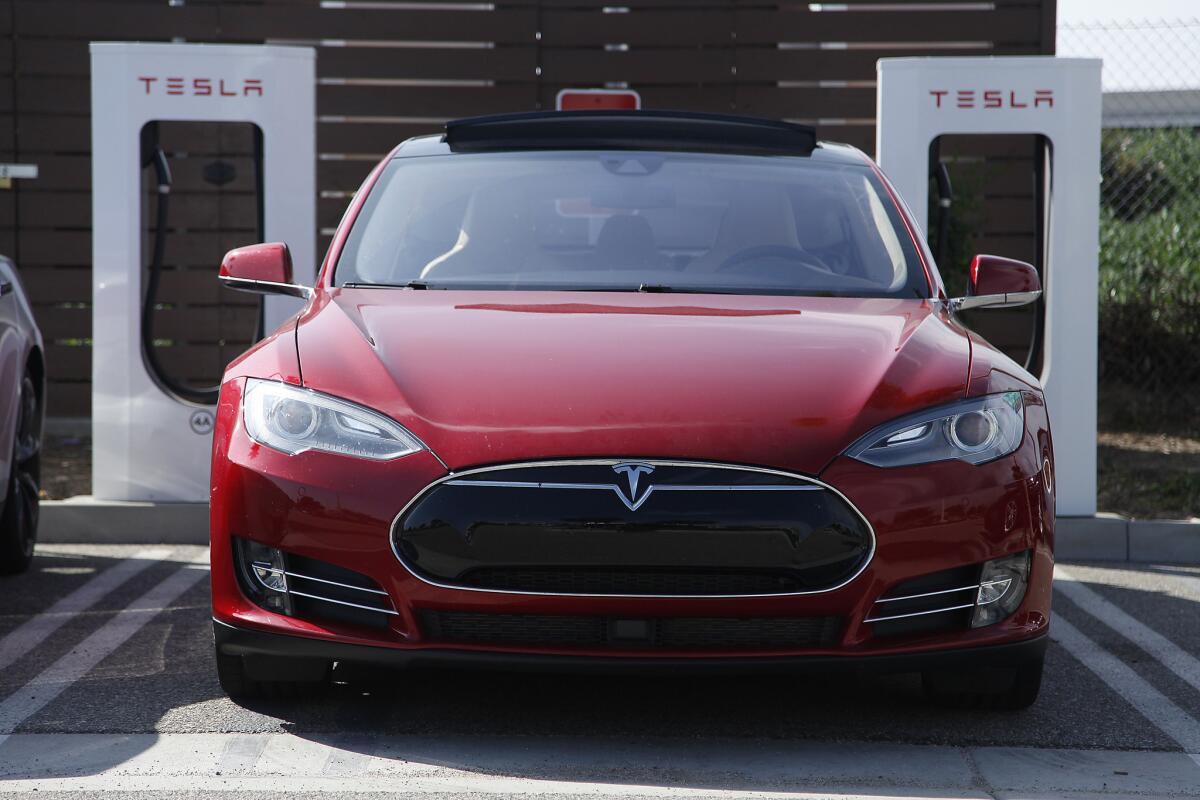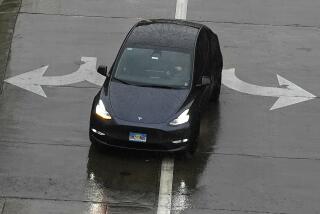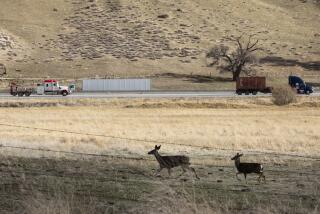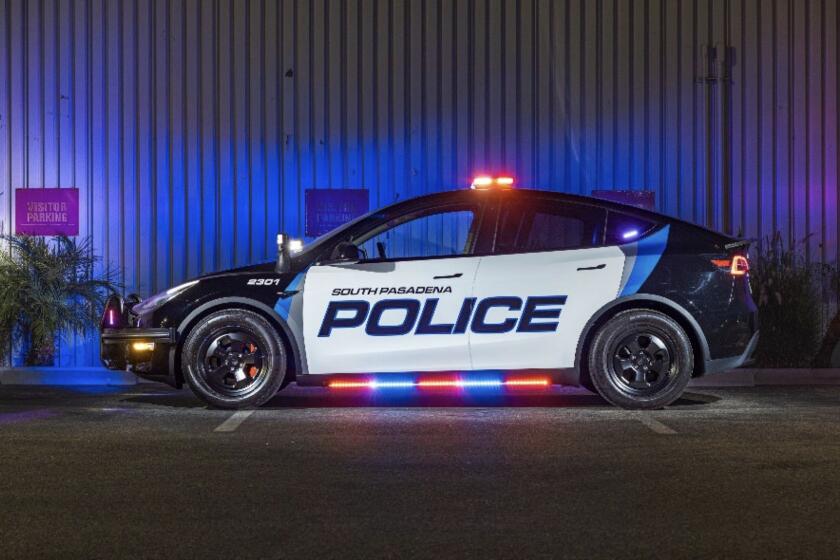Driving the Model S P85 D long-distance

Beyond the speed and luxury offered by Tesla’s Model S, the real key to its success — and its premium price — is the longest driving range offered by any electric car.
The EPA’s official range for Tesla’s new, faster Model S P85D is 253 miles. That’s more than double the distance offered by more affordable electric cars, and eliminates much of the “range anxiety” that keeps most drivers from going electric.
But is the Tesla practical for long trips?
I drove a P85D from Tesla’s Palo Alto headquarters to Los Angeles, and found that distance driving still presents interesting challenges, even with advent of Tesla’s supercharger network.
I left Tesla’s bucolic headquarters, nestled among rolling hills and equestrian trails east of Palo Alto, with a not-quite-full battery “tank.” The odometer was at 601 miles, and the dashboard information screen told me I had a “rated” range of 226 miles and a “projected” range of 197 miles.
The difference between the two? Rated, based on the EPA’s range rating, is a measure of how much distance could theoretically be driven using the amount of energy in the battery. Projected — based on the driver’s recent driving style — seeks to be more of a real-world estimate of expected mileage on a particular trip. (I learned that the previous user had driven the P85D very fast.)
I set the navigation system for the Tesla supercharger station at Gilroy — 47 miles to the south — asked the sophisticated sound system to play me something by Dexter Gordon, and set out to the tune of “Second Balcony Jump.”
An hour of light freeway traffic later, I slid into the Gilroy station, which is attached to an outlet mall. The odometer read 654 miles. The in-dash information system told me I had a rated range of 170 miles. So, I’d used about 56 miles’ worth of electricity to travel 54 miles. Not bad!
Having plugged in, alone at a line of 10 empty charging stations, I went for a stroll and a coffee. Thirty minutes later, my charge restored to a rated range of 234 miles, and a projected range of 228 miles, I set the nav system for Cambria, 154 miles away.
The road opened up. Only the mellow sound of Bill Evans’ “My Foolish Heart” disturbed the smooth silence of the Tesla as it slid south on the 101. With no traffic, I set the cruise control for 70 mph and enjoyed the sight of a full moon rising over the Salinas Valley.
At 70 mph, I began to notice the “projected” range falling at a sharper rate than it had when, in moderate traffic, I was moving more slowly.
Somewhere near Soledad, the dash told me my destination was 113 miles away, with a projected range of 185 miles. Further on, those numbers got closer — destination 81 miles, range 123 miles. By the time I was five miles from Cambria, I was down to a projected range of 40 miles.
That’s cutting it close, and induced a little of the dreaded range anxiety.
I had planned to stay overnight at a hotel featuring a dedicated Tesla charging station, one of a network of 300 such locations nationwide.
But when I checked in, and plugged in, I discovered the charging station did not work. And, with under 40 miles of electricity left, I was now more than 40 miles from the nearest supercharging station, at Atascadero.
Fortunately, the hotel had a sister property just blocks away with a functioning charging station. I changed hotels, plugged in, and by morning had a full battery. The dashboard told me I had a reassuring projected range of 261 miles.
I set my destination for the supercharger at Buellton, and to the strains of Debussy turned south once more. A couple of sightseeing hours later, enjoying a few twisty back roads, I plugged in at the eight-stall Buellton station. My dash told me I had used 128 miles of projected range to drive 100 miles.
One other stall was occupied by Malcolm Wallop, who said he’d put 50,000 miles on his electric car since paying about $82,500 (after rebates) to have Tesla deliver a brand new 2013 Model S to his home in Sheridan, Wyo.
In almost two years of owning his Tesla, Wallop had toured the entire American West, topping up at every supercharger station around and using the occasional RV park when necessary. (He once paid $38 to rent an RV stall to get overnight access to a wall plug.)
”I love this car more than anything I’ve ever owned,” he said.
After 40 minutes, I was back to a projected range of 221 miles. Feeling more confident about the battery’s performance, I headed east into the hills to enjoy some of the car’s performance.
I hit some twisties. I explored the P85D’s massive acceleration. I may have exceeded the speed limit here and there. But I left the car in “Sport” driving mode, eschewing the only other setting choice, “Insane.”
So when I landed at the outdoor mall that houses Tesla’s Oxnard supercharger station, I was not surprised to see a difference between the actual and projected miles used – 77 miles of driving, but a 97-mile drop in the projected range.
It took about half an hour to recharge to a projected range of 220 miles, more than enough to cover the estimated 61 miles back to my home base. (A handy app makes it possible to view the charge level, and other details about the car, remotely.)
The traffic was light, and moving at 70 mph. So when I landed, I had expended about 80 miles of projected range to cover 61 miles of roadway.
In addition to a little range anxiety before reaching my hotel, I experienced what I would call “performance anxiety” throughout the trip — a reluctance to tap the awesome power and torque the Tesla offers, for fear of draining its battery too quickly.
But Wallop, my friend from Buellton, told me that after 50,000 miles in his Tesla he’d gotten used to the rhythms of charging. Though he’d once run the battery down to zero, caught between charging stations in a bad headwind near Barstow, he’d never run out of juice.
“Tesla says zero means zero, but I went seven miles past zero, and still got to the next supercharger,” Wallop said.
Tesla now has superchargers installed up and down the state. It’s possible to hurry from the Bay Area to Los Angeles down the I-5, stopping at Harris Ranch, near Coalinga, or Tejon Ranch, near Grapevine. You can drive and charge down the 101, stopping at Gilroy, Atascadero, Buellton or Oxnard.
But where’s the fun in that? Tesla and other companies also offer dozens of slower chargers, at hotels, inns and wineries dotted throughout the state. Traveling that way really puts some adventure back into the long-distance driving experience.
Twitter: @misterfleming







